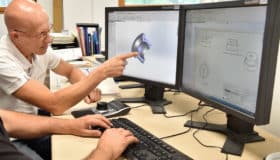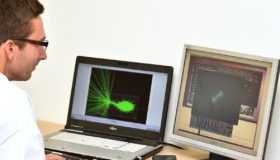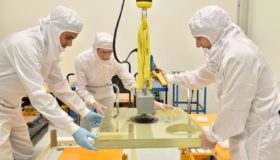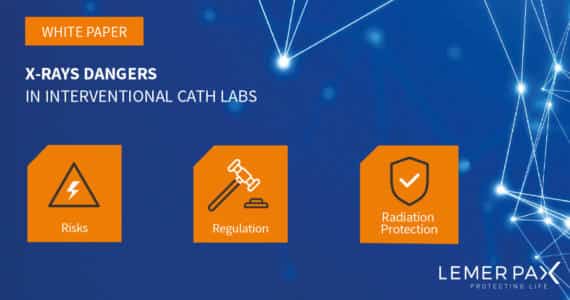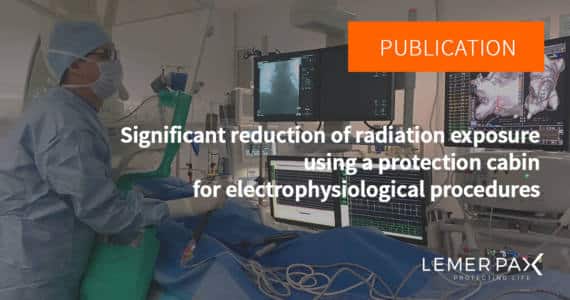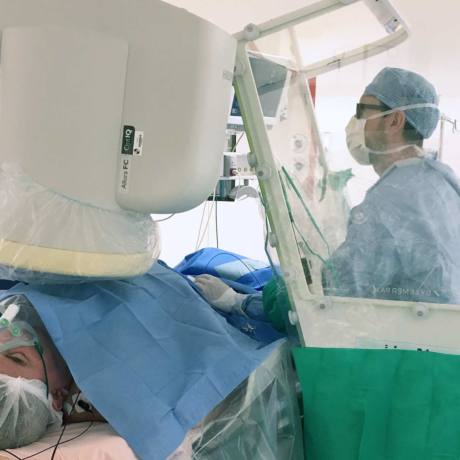
Evaluation of a radiation protection cabin for invasive electrophysiological procedures
Octavian Dragusin, Rukshen Weerasooriya, Pierre Jaïs, Meleze Hocini, Joris Ector, Yoshihide Takahashi, Michel Haïssaguerre, Hilde Bosmans, and Hein Heidbüchel. European Heart Journal. Janvier 2007
Over the last decades, the number and complexity of invasive electrophysiological procedures have dramatically increased. This may result in high cumulative operator radiation exposure that could lead to stochastic and deterministic effects.
The occupational doses should not exceed < 20-50mSv per year for whole body radiation. Besides, Radiation protection is mandatory.
2 solutions are possible :
- Lead aprons, thyroid shields and goggles. Lead aprons are heavy and result in operator discomfort and fatigue during prolonged procedures.
- Radiation Protection cabins : 2mm lead equivalence, mobile, adjustable height, quick and easy setting up of the sterile kit, leaded cuffs, easy movement of the operator, may be removed in less than 30 sec.
OBJECTIVE:
Evaluation of a radiation protection cabin compared to conventional protection with lead aprons.
- Primary objective : to prove that the RPC provides full radiation protection so that working without conventional protection apparels is safe.
- Secondary objective : to show that working with the RPC does not negatively impact procedure outcome.
METHOD & RESULTS:
Both centres compared electrophysiological procedures with protection provided by classical means « Aprons » (lead apron, thyroid collar, and googles) or by the RPC.
Measurements were performed in two centres (Leuven, Belgium / Bordeaux, France)
Centres 1 :
- Thermoluminescent dosimeters (TLD) at 16 points on the cabin’s walls, eight inside and height outside and 9 points inside and outside of the lead apron ; Sensitivity threshold 10-20 Sv
- 35 procedures : 25 with the cabin and 10 with the lead apron
- Several procedures performed : 9 diagnostic procedures and several ablations procedures (15 paroxysmal supraventricular tachycardia –AV nodal reentrant tachycardia or accessory pathway, 7 right atrial flutter and 4 atrial fibrillation)
- Performed by the same operator
- Femoral access
The doses outside the RPC or apron showed very similar values for unprotected areas with medians ranging from 57 to 452 μSv and from 45 to 335 μSv, respectively. Radiation to the head was significantly lower within the RPC (1.9±1.2 vs 102±23 μSv) than for the Apron group.
Centre 2 :
- More sensitive electronic personal dosimeters (EPD) placed at the anterior waist and neck level ; Sensitivity threshold (< to TLD) 1-1.5μSv
- 80 procedures : 40 with the cabin and 40 with lead aprons
- Procédures performed : Only more complex and longer AF ablations
- Performed by 3 operators
- Femoral access
The radiation dose in protected areas was at the sensitivity threshold i.e at background values (1.3±0.6μSv for RPC and 3.0±2.2μSv for Apron.
However, radiation to the head was significantly lower within the RPC (1.9±1.2 vs. 102±23μSv for the Apron group, P<0.001)
CONCLUSION:
The use of the RPC allows to perform catheter ablation procedures without hindrance and with negligible radiation exposure for the operator.
